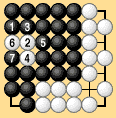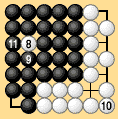 |
2.3.10 The Rules of Alternate Play and the End of the Game
|
It is only plain common sense that go is played on the principle of
alternate moves, but when the thousand-year ko problem, the problem
of connecting a final ko, the problem of reinforcing territory, the
hane-seki problem or other problems that we have seen arise, the issue
of whether alternate play is a right, a duty, or both a right and a duty
becomes critical.
An important related problem is defining the end of the game. You cannot
just have one player declare that the game is over. If the right to move
is a duty, then consider Dia. 2-25-1. By common sense Black should win
this game, but what if White refuses to agree to end the game?
|
|
If passing is not allowed, then play will continue as in Dias. 2-25-2
and 2-25-3, and if White demands that play still continue, Black will be
wiped out. This is ridiculous, so naturally we had better let a player
pass the right to move. Then there is the question of deciding whether,
when a player passes, he has to pay a penalty.
|
 |
 |
| Dia. 2-25-2 |
Dia. 2-25-3 |
|
The definition of the end of the game is very unclear in the Japanese
rules. When no problem position arises the end of the game is
generally clear by common sense, but if a problem does arise, it can
be unexpectedly hard to solve. The rules should make the game end
automatically, instead of through a unilateral declaration or indication
by one of the players. For example, you can have the game end when both
players pass in succession.*
This is also an important question in area rules, but it requires
particularly close attention in territory rules.
|
- *
- The 1989 Japanese Rules of Go have the game stop at two consecutive
passes, with provisions for resuming play if necessary.
|
| |
 |




